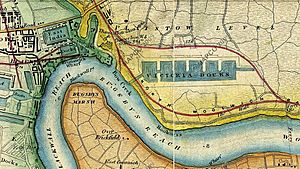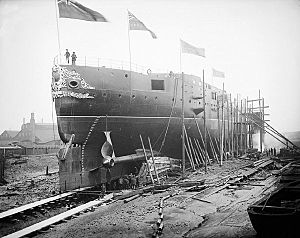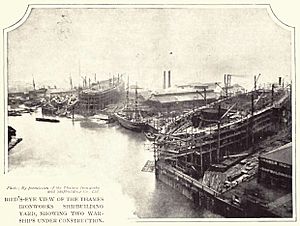Thames Ironworks and Shipbuilding Company facts for kids
| Industry | Shipbuilding |
|---|---|
| Fate | Defunct |
| Founded | 1837 |
| Defunct | 1912 |
| Headquarters | London |
The Thames Ironworks and Shipbuilding Company, Limited was a big company in London, England. It built ships and worked with iron. The company was located where Bow Creek meets the River Thames, with parts in Leamouth Wharf (also called Blackwall) and Canning Town.
While its main job was shipbuilding, it also did other cool things. These included building parts for bridges, making marine engines (ship engines), cranes, and even early electrical items and motor cars.
A famous project was making iron parts for Isambard Kingdom Brunel's Royal Albert Bridge in the 1850s. They also built the world's first warship made completely of iron, HMS Warrior, launched in 1860.
Contents
How the Company Started and Grew
Early Days: 1837–1846
The company began in 1837 as the Ditchburn and Mare Shipbuilding Company. It was started by a shipwright (someone who builds ships) named Thomas J. Ditchburn and an engineer named Charles John Mare.
They first had a yard in Deptford, but after a fire, they moved in 1838. Their new spot was at Orchard Place, between the East India Dock Basin and Bow Creek. They took over the space from shipbuilders who had closed down.
The company quickly became successful. In just a few years, they used three different sites, covering a large area of over 14 acres (5.7 ha).
Ditchburn and Mare were among the first to build iron ships in that area. They started with small paddle steamers, then moved on to bigger ships that could cross the English Channel. By 1840, they were building ships weighing more than 300 tons!
They built ships for companies like the Iron Steamboat Company and the Blackwall Railway Company. For the railway company, they made paddle steamers like the Meteor and the Prince of Wales. These ships traveled between Gravesend and the company's station.
During this time, the company also got contracts from the Admiralty (the British Navy). One of their first iron warships was HMS Recruit, a 12-gun brig. They also built steamers like Ariel and Erin for the P & O Company, and the paddle steamer Preussischer Adler for Prussia.
Growing Bigger: 1847–1856
In 1847, Thomas Ditchburn retired. Charles Mare continued the business, calling it C.J. Mare and Company. He was joined by James Ash, another naval architect.
From 1847, the company grew a lot. Mare bought land on the Canning Town side of the River Lea, and they even set up a ferry to connect their two sites.
Mare built a yard with furnaces and rolling mills. This allowed them to build very large ships, up to 4,000 tons! The older Orchard Place site could only build ships smaller than 1,000 tons. In 1853, the company launched the SS Himalaya for the Peninsular and Oriental Steam Navigation Company. For a short time, it was the world's largest passenger ship before it became a naval troopship (a ship for carrying soldiers).
By 1855, the company had over 3,000 employees. However, it faced big financial problems and was almost shut down. Some people think this happened because payments for completed work were delayed, or maybe the company miscalculated how much it would cost to build ships for the Royal Navy. Even with these problems, they still had many orders, including six contracts for gunboats and a contract for Westminster Bridge.
The New Company: 1857–1912

The company's main lenders wanted to keep it running. Two employees, Joseph Westwood and Robert Baillie, were put in charge of the works. The most important person in saving the company was Peter Rolt. He was Charles Mare's father-in-law and a Conservative MP for Greenwich. Rolt was also a timber merchant and came from the famous Pett shipbuilding family. Another director, Lord Alan Spencer-Churchill, also helped.
Rolt took control of the company's assets. In 1857, he created a new company called the Thames Ironworks and Shipbuilding and Engineering Company Ltd.. It had a capital of £100,000. Rolt was the main shareholder and the chairman of the board.
The new company became the biggest shipbuilder on the Thames. In 1861, the Mechanics' Magazine called its workshops "Leviathan Workshops" (meaning huge workshops). Maps from the 1860s show the main yard was a large triangle on the east bank of Bow Creek. It had a quay (a place for ships to dock) that was 1,050 feet (320m) long. Today, the A1020 Lower Lea Crossing and the Docklands Light Railway cross this area.
By 1863, the company could build 25,000 tons of warships and 10,000 tons of mail steamers at the same time! One of its first contracts for the Admiralty was for HMS Warrior, launched in 1860. At that time, it was the world's largest warship and the first armored frigate with an iron hull. HMS Minotaur followed in 1863. It was 400 feet (120 m) long and weighed 10,690 tons.
Work on huge ships like Minotaur was done on the Canning Town side of the Lea. This is where the Thames Ironworks grew from less than 10 acres (4.0 ha) in 1856 to 30 acres (12 ha) by 1891. The old Orchard Place site was still the official address until 1909, but most of the work happened in Canning Town.
Building ships on the River Thames became very difficult because yards in the north of England had cheaper access to coal and iron. Many yards closed after the financial crisis of 1866. The companies that survived, like Thames Ironworks, focused on building warships and large passenger ships.

After the success of HMS Warrior and HMS Minotaur, navies from all over the world placed orders. The yard built ships for Denmark, Greece, Portugal, Russia, Spain, and the Ottoman Empire. They also built the Prussian Navy's first iron-hulled warship, the SMS König Wilhelm in 1868. Many smaller warships were also built for the Romanian Navy, like the brig Mircea.
In the 1890s, a kind person named Arnold Hills became the managing director. He had joined the board of directors in 1880 when he was only 23. Hills was one of the first business leaders to give his workers an eight-hour day. This was a big deal, as most industrial workers at the time worked 10 or 12-hour shifts.
In 1895, Hills helped start a football club for the company's employees, called Thames Ironworks F.C.. Within two years, they were playing in the FA Cup and the London League. Because the club wanted to hire professional players, Thames Ironworks F.C. closed in June 1900. A month later, West Ham United F.C. was formed.
In 1899, the company merged with an engine builder called John Penn and Sons. It became the Thames Iron Works, Shipbuilding and Engineering Co.
During its time, the yard built 144 warships and many other vessels. In 1911, Arnold Hills asked Winston Churchill, who was in charge of the Navy, for more orders. He was not successful, and the yard had to close in 1912. Just two years later, the United Kingdom was at war with the German Empire. The last major ship built by the yard even took part in the Battle of Jutland.
The Royal Flying Corps (which started in 1912) later bought the Thames Iron Works site in Greenwich in 1915. They used it to store aeroplanes.
Archaeology Discoveries
Part of the company's Limmo Peninsula site was dug up by archaeologists in 2012. This happened during the building of Crossrail, a new railway line.
Amazing Things They Built
- In the 1850s, the company made iron parts for I.K. Brunel's Royal Albert Bridge over the Tamar in Saltash.
- Between 1897 and 1912, the company made the ironwork for the Kotri Bridge in Sindh Province, Pakistan.
- HMS Warrior, launched in 1860, was the world's first warship made entirely of iron. When it was finished in 1861, Warrior was the biggest, fastest, most heavily armed, and most armored warship in the world!
- In the 1890s, the yard built two of the six British-made battleships that were important for the Japanese Navy in the Russo-Japanese War of 1904–1905.
- The launch of HMS Albion in 1898 had a sad accident. Several people died when a bridge collapsed.
- The last big warship built by the yard was HMS Thunderer (22,500 tons). It was launched in 1911.
Ships Built by the Company
- HMS Trident, Royal Navy, 1845 (Ditchburn & Mare)
- HMS Recruit, Royal Navy, 1846, an iron brig.
- DS Rigi, 1847. It was used on Lake Lucerne (Switzerland) until 1952. Now, it's on display at the Swiss Transport Museum.
- PS Vladimir, 1848 (C J Mare), a "Russian War Steamer"
- Argo, 1853, the first steamship to travel all the way around the world.
- SS Himalaya, 1853 (C J Mare), for Peninsular and Oriental Steam Navigation Company, later HMS Himalaya for the Royal Navy.
- HMS Warrior, Royal Navy, 1860
- Yavari and Yapura, Peruvian Navy, 1862. These were sent in pieces and put together on Lake Titicaca.
- Mahmudiye, Ottoman Navy, 1863
- HMS Minotaur, Royal Navy, 1863
- RUS Pervenetz, Imperial Russian Navy, 1863
- HMS Valiant, Royal Navy, 1863
- Victoria, frigate, 1865
- SNS Vitoria, Spanish Navy, 1865
- HMS Serapis, Royal Navy troopship, 1866
- Anglia, 1866, an iron paddle tugboat.
- SMS König Wilhelm, 1869, Prussian Navy
- Avnillah, Ottoman Navy, 1869
- Feth-i Bülend, Ottoman Navy, 1870
- HMS Magdala, Royal Navy, 1870
- Hamidiye, Ottoman Navy, 1872, later bought by the Royal Navy as HMS Superb
- Mesudiye, Ottoman Navy, 1872
- PS Castalia, English Channel Steamship Company, 1874
- Mindello, Portuguese Navy, 1875
- Rainha De Portugal, Portuguese Navy, 1875
- Vasco da Gama, Portuguese Navy, 1876
- Fox 1877, an iron tugboat
- Canada 1880, a Screw Tugboat
- HMS Linnet, Royal Navy, 1880
- NRP Afonso de Albuquerque, Portuguese Navy, 1884
- HMS Benbow, Royal Navy, 1885
- HMS Sans Pareil, Royal Navy, 1887
- HMS Blenheim Royal Navy, 1890
- SS Robin, Arthur Ponsonby, 1890
- HMS Grafton, Royal Navy, 1892
- HMS Theseus, Royal Navy, 1892
- Battleship IJN Fuji, 1896
- Battleship Shikishima, 1898
- HMS Albion, Royal Navy, 1898
- HMS Cornwallis, Royal Navy, 1901
- HMS Duncan, Royal Navy, 1901
- Cromer Lifeboat Louisa Heartwell ON 495, RNLI 1902
- HMS Black Prince, Royal Navy, 1904
- J C Madge, RNLI, Sheringham lifeboat, 1904,
- HMS Nautilus, Royal Navy, 1910, later named HMS Grampus
- HMS Thunderer, Royal Navy, 1911
The Link to West Ham United Football Club
Employees at the Thames Ironworks started their own football team, called Thames Ironworks Football Club. This club later changed its name to West Ham United.
The club's emblem (logo) shows crossed hammers. These represent the large riveting hammers used in shipbuilding. This is why West Ham United is often called "The Hammers."
While the media and most football fans call them "The Hammers," the club's own supporters have always called their team "The Irons." This also comes from the link with Thames Ironworks. You can hear the chant "Come on you Irons" at every West Ham match.
The design of the club's badge, updated in 2016, looks like the front (bow) of HMS Warrior. This was the first iron-clad battleship, built by the Thames Ironworks in 1860.


